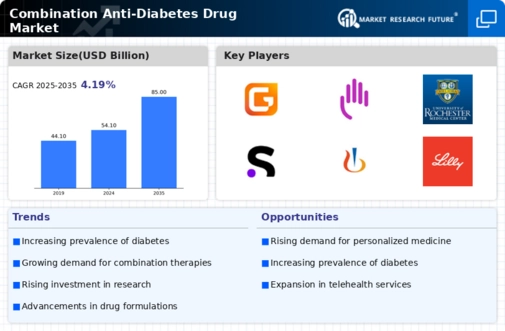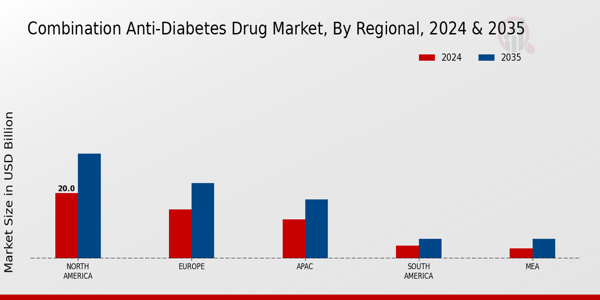Market Trends and Projections
Rising Prevalence of Diabetes
The increasing prevalence of diabetes globally serves as a primary driver for the Global Combination Anti-Diabetes Drug Market Industry. According to the World Health Organization, the number of adults living with diabetes has risen significantly, with projections indicating that by 2030, approximately 578 million people will be affected. This alarming trend necessitates the development and adoption of combination therapies, which are often more effective in managing blood glucose levels than monotherapy. As a result, the market is expected to reach a valuation of 54.1 USD Billion in 2024, reflecting the urgent need for innovative treatment options.
Advancements in Drug Formulations
Innovations in drug formulations are propelling the Global Combination Anti-Diabetes Drug Market Industry forward. Pharmaceutical companies are increasingly focusing on developing fixed-dose combinations that enhance patient compliance and simplify treatment regimens. These advancements not only improve therapeutic outcomes but also reduce the pill burden on patients. For instance, the introduction of combination drugs that integrate GLP-1 receptor agonists with insulin has shown promising results in clinical trials. As the market evolves, it is anticipated that the industry will grow at a CAGR of 4.18% from 2025 to 2035, reaching an estimated 85 USD Billion by 2035.
Increased Awareness and Education
Heightened awareness and education regarding diabetes management are crucial drivers for the Global Combination Anti-Diabetes Drug Market Industry. Public health campaigns and educational programs have significantly improved understanding of diabetes and its complications, leading to earlier diagnosis and treatment. This shift in awareness encourages patients to seek effective combination therapies that can better manage their condition. Furthermore, healthcare providers are increasingly recommending these therapies as first-line treatments, contributing to the market's growth. As awareness continues to expand, the demand for combination anti-diabetes drugs is likely to increase, further solidifying their role in diabetes care.
Government Initiatives and Support
Government initiatives aimed at combating diabetes are instrumental in shaping the Global Combination Anti-Diabetes Drug Market Industry. Many countries have implemented national diabetes prevention programs, which promote the use of effective treatment options, including combination therapies. These initiatives often include funding for research and development, as well as subsidies for patients to access necessary medications. For example, the U.S. government has allocated substantial resources to diabetes research, fostering innovation in drug development. Such support not only enhances the availability of combination anti-diabetes drugs but also encourages pharmaceutical companies to invest in this growing market.
Emerging Markets and Economic Growth
The expansion of emerging markets presents a significant opportunity for the Global Combination Anti-Diabetes Drug Market Industry. As economies in regions such as Asia-Pacific and Latin America continue to grow, there is an increasing demand for effective diabetes management solutions. Rising disposable incomes and improved healthcare infrastructure in these regions facilitate greater access to combination therapies. Moreover, the prevalence of diabetes is also on the rise in these markets, further driving the need for innovative treatment options. Consequently, pharmaceutical companies are likely to focus their efforts on these regions, contributing to the overall growth of the market.
























